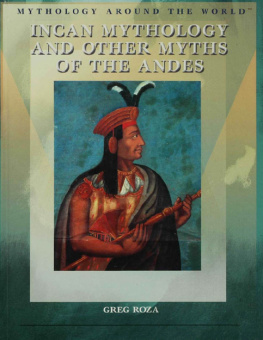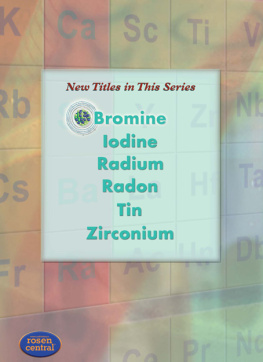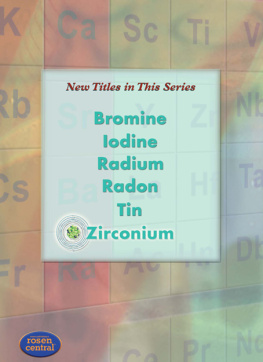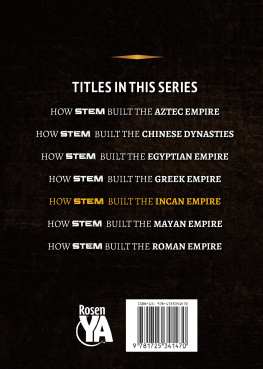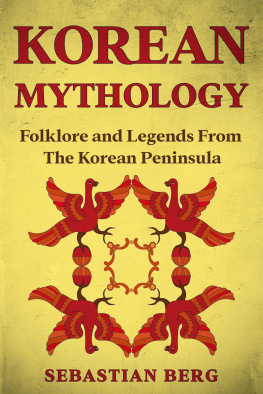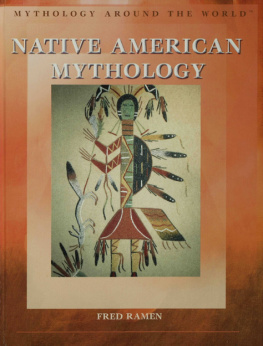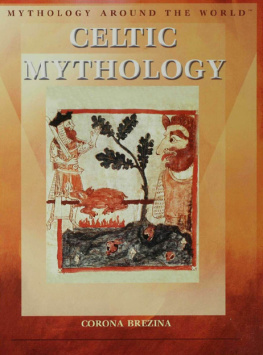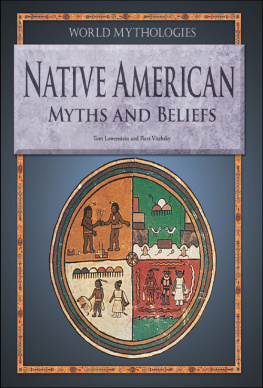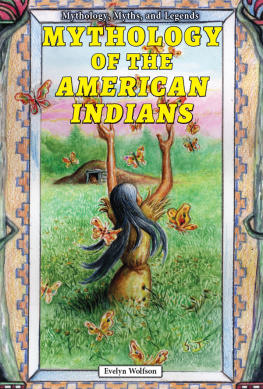Page List

For Kathy
Published in 2008 by The Rosen Publishing Group, Inc.
29 East 21st Street, New York, NY 10010
Copyright 2008 by The Rosen Publishing Group, Inc.
First Edition
All rights reserved. No part of this book may be reproduced in any form without permission in writing from the publisher, except by a reviewer.
Library of Congress Cataloging-in-Publication Data
Roza, Greg.
Incan Mythology and Other Myths of the Andes / Greg Roza.1st ed.
p. cm.(Mythology around the world)
Includes bibliographical references and index.
ISBN-13: 978-1-4042-0739-4
ISBN-10: 1-4042-0739-2
1. Inca mythology. 2. Inca cosmology. 3. IncasReligion. 4. LegendsAndes Region.
I. Title. II. Series.
F3429.3.R3R69 2007
299.88323013dc22
2006000169
Manufactured in the United States of America
On the cover: Atahualpa (15021533), the last independent emperor of the Inca, was captured and eventually executed by Spanish invaders.
CONTENTS
A ll members of a culture share the need to understand who they are and where they came from. While modern humans depend on science and religion for answers to their questions about existence, earlier peoples had to rely on their imagination and observation of nature. Myths are traditional stories presenting supernatural beings, ancestors, or heroes who serve as representations of certain ideas and character types. They are the response of primitive societies that sought to understand their place in the world.
Among the most colorful and enthralling of world mythologies is that of the Inca. The Incan civilization encompassed a wide range of customs and beliefs. The Inca called their empire Tahuantinsuyu, which means the land of the four quarters. This name refers to the four regions of the empire that radiated out from Cuzco, in present-day Peru. Each region was governed by strong leaders who answered to the emperor. Tahuantinsuyu included hundreds of Andean tribes, cultures, and languages. The empire also incorporated the many myths of the various Andean peoples. These myths which evolved into a body of tales that we now refer to as Incan mythology. It is this process of assimilation and cultural layering that makes Incan mythology such a rich and complex brew of Andean folklore, history, and belief.
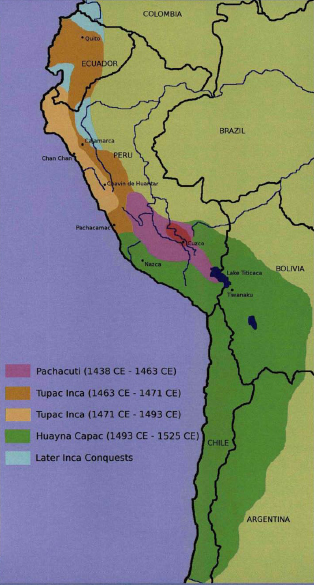
This map illustrates the expansion of the Incan Empire over the course of eighty-seven years.
S cientists believe nomads originally from Asia began populating the western coast of South America about 10,000 years ago. Living conditions in this area are harsh and rugged. South Americas Pacific coast has been one of the driest locations on Earth for thousands of years. The towering peaks of the Andes Mountains line the entire length of western South America. This area also features ancient glaciers, active volcanoes, and fault lines that have resulted in destructive earthquakes.
Around 7500 BCE, the first settlements formed along rivers in the lowlands and on plateaus in the highlands. Remarkably, many cultures flourished here. Most of these settlements were small and isolated from other settlements, and the people that built them developed innovative methods of survival. The first cities began cropping up around 2600 BCE. These cities were usually uninhabited by full-time residents and were instead used as gathering centers for the purposes of government, commerce, and religious festivals. The various independent and isolated cities and settlements of the Andes region would sometimes be drawn into the orbit of one of the areas more dominant and powerful cultures. Empires of this kind united the vast territory of scattered peoples under a single governing structure and ruler. The first empire in the Andes rose and fell before 1000 CE.
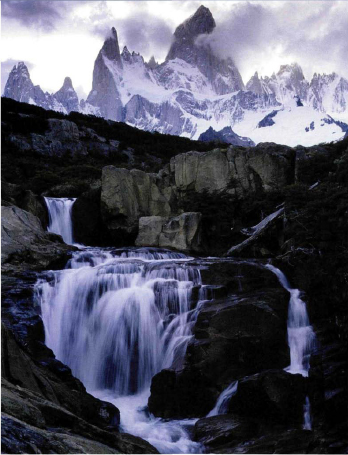
Mt. Fitz Roy looms over a waterfall in Los Glaciers National Park in the Santa Cruz Province in Argentina. A large part of this park lies along the Andes Mountains. It is named for a huge ice cap in the Andes range. This is the largest ice cap in the world outside of Antarctica; it feeds forty-seven separate glaciers.
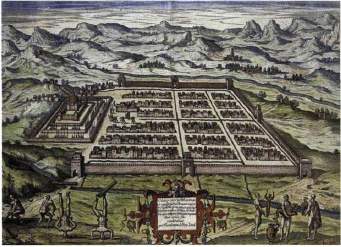
The Incan city of Cuzco appears in this 1596 color engraving. Cuzco was the center of the Incan civilization during the reign of King Huascar.
The Inca formed the most powerful and famous of the Andean empires. The first Inca settled in the Cuzco Valley of the Andes around 1200 CE, perhaps earlier. The first Incan village was situated at Cuzco, which would remain the center of the Incan civilization until its downfall in the early 1500s following the Spanish conquest. The Inca began as a small tribe. They survived for hundreds of years, mainly due to their location high in the mountains where few other civilizations could find and attack them. Eventually, however, the Inca began to thrive and grow.
Due to a lack of resources and farmland for their growing population, the Inca needed to spread beyond their central location at Cuzco. They were an aggressive, warlike people, according to archaeological and mythological evidence. So the Inca eventually began to control vast stretches of the west coast of South America. By the fifteenth century, they had formed a full-fledged empire.
Thirteen Kings
While much of early Incan history is clouded by myths and legends, most experts agree that there were thirteen distinct Incan leaders, or kings. (The kingdom centered at Cuzco didnt become an empire until the reign of Pachacuti, who lived from 143871.) The word Inca was actually their title for the king. It was the Spanish explorers who first used the name Inca to describe the entire people ruled by the king. The names of the first seven Incan rulers were derived from local legends of war chiefs and ruling dynasties. The remaining six rulers are historical figures. The thirteen Incan kings are:
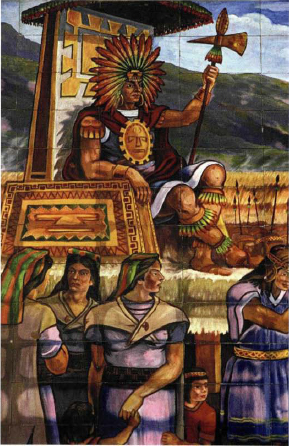
An enthroned Atahualpa prepares to meet the Spanish conquistador Francisco Pizrro. Pizarra would capture Atahualpa in 1532 and use him to gain control over the Incan Empire.
Manco Capac
Sinchi Roca
Lloque Yupanqui
Maita Capac
Capac Yupanqui
Inca Roca
Yahuar Huacac
Inca Viracocha
Pachacuti (Inca Yupanqui)
Topa Inca Yupanqui
Huayna Capac
Huascar
Atahualpa
The Land of the Four Quarters
The Incan Empire lasted a very short time, from about 1438 until it was conquered by the Spanish in the early 1530s. During this period, the Inca quickly dominated much of the area that is today Peru, Bolivia, northern Argentina, Chile, and Ecuador, some 2,500 miles (4,023 kilometers) along the western coast of South America. Only the fierce tribes of the dense Amazon rainforest stopped them from expanding farther east. At its height, about ten million people lived in the Incan Empire, although as few as 40,000 of those people were actually Incan. The rest were members of tribes that had been conquered by the Inca. The Incan Empire was one of the largest and richest civilizations ever to rule in the Americas.

